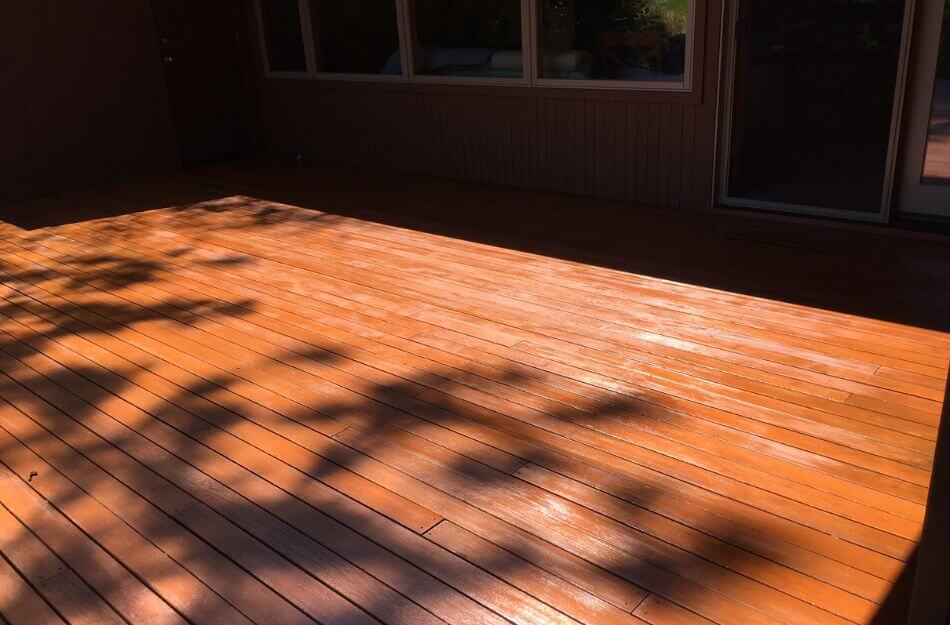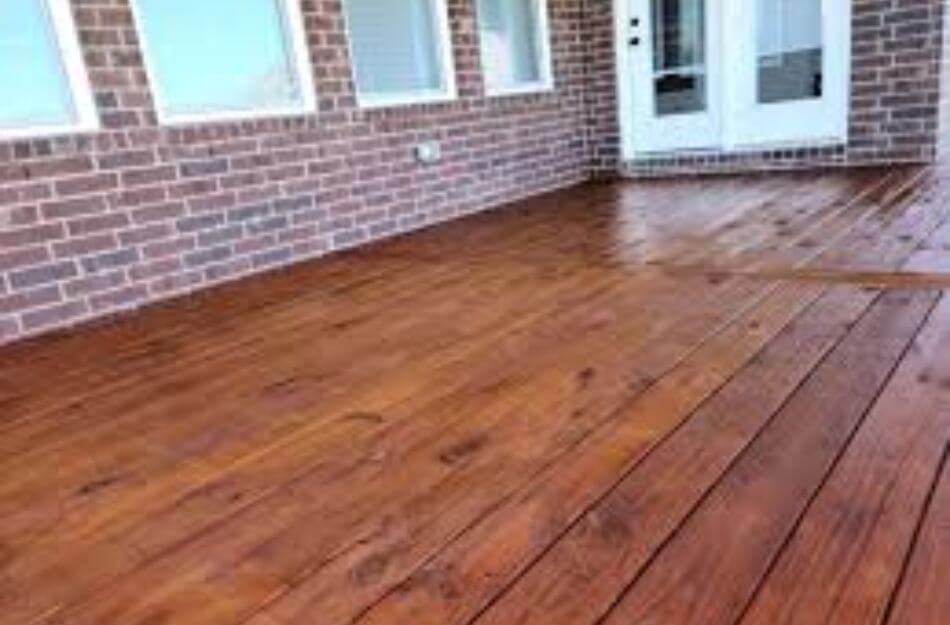Oiling or staining your deck are the two most common ways to treat it. It can be challenging to distinguish between oiling and staining your deck because they share some characteristics despite being meant for slightly different purposes.
The difference between deck and oil stain is deck oils are specially refined oils that restore and safeguard your deck’s surface. It defends your deck boards from damaging moisture, UV rays, and microorganisms. Deck stains are packed with pigment oils that can color your deck surfaces. Your deck will last longer, and you won’t need to replace it as soon. While a stain will alter the decking wood’s hue and appearance.

When applied to various kinds of wood, stains’ hues and tints produce varying visual effects. While keeping the integrity of the wood’s natural grain, decking oil will only improve the wood’s appearance.
Decking oil is superior for durability and protection, even though applying a deck stain to a deck is a fantastic way to change an outdoor area.
Table of Contents
Decking Oil
Decking oil guards wood against moisture, deterioration, and UV radiation.
Decking oil, available in transparent and colored varieties, replenishes the wood as its inherent oils deteriorate with time while preserving its natural characteristics.
It’s also important to remember that darker oils offer more UV protection than transparent ones.
Oil, unlike wood stains, is not intended to alter the wood’s overall appearance or hue. However, the wood occasionally becomes slightly darker after applying the oil.
Decking oil enables the wood grain to show through, unlike other surface-sitting stains and deck paints.
Water or oil-based decking lubricant is available.
Remember that cleaning up after using an oil-based product requires mineral spirits rather than detergent and water that you can utilize in water-based products.
Applying decking oil to a deck is reasonably simple, which can prevent it from warping, division, and cracking as the wood ages.
Also Read: Kreg Deck Jig Vs Camo: Which Decking System is Better?
Deck Stain
Compared to decking oil, the decking stain is a little different. Stain is a substance that covers the deck’s surface and resembles varnish.

The decking boards are shielded from the sun, rain, bacteria, algae, and various other elements by it, acting as a barrier between the wood and foreign objects that could harm it.
Stains are simple to apply with a paintbrush and come in a broad range of wood tones. Stains improve the boards’ overall look while bringing out the natural wood grain.
The purpose of this substance is to alter the hue of the wood.
Depending on your stain style, the finish will be transparent (all of the wood grain is visible), semi-transparent (some of the wood grain is visible), or solid. (you can see no wood grain).
We advise resting annually for upkeep, much like decking oil. It ultimately relies on how the wood and stain fare when exposed to the weather.
Water-based stains and oil-based stains are the two kinds of stains that you can purchase at home improvement stores.
Water-Based Stains
Water-based stains don’t penetrate the wood but rest on top of it after application. Unlike oil-based stains, this kind cures much more quickly.
Additionally, you only need soap and water to remove the stain from brushes and fingertips easily.
Oil-Based Stains
These colors penetrate the wood while still allowing the wood grain to be seen. It’s also simple to touch up and repeat as necessary. Because it is solvent-based, you must use mineral oil or other chemicals to get the stain off of your skin, tools, and applicators.
Pros and Cons of Deck vs. Oil Stain
Deck Oil Pros
- Exceptional covering, typically 8 to 12 square feet per liter. Some decking lubricants have a 24 square meter per liter coverage capacity.
- Depending on the type and brand of decking oil product, available to use for moderate foot traffic in 4 to 8 hours.
- Many have UV filters to lessen the impacts of UV deterioration on the wood. Generally, darker decking oils offer greater UV protection than clear or lighter-colored ones.
- They assist in replenishing the wood’s natural oils, keeping it healthy and flexible.
- Oils protect the decking planks from warping, cracking, and splitting from within.
- Decking oils are simple to apply, keep, and clean. Before using a replenishing or management top coat, there is no need to bare the wood.
- It is simple to perform localized patch fixes to worn areas in heavy traffic areas.
- Decking oils won’t cause the wood’s surface to blister, peel, flake, or fracture.
- When properly kept, they aid in preventing mold and algae growth in decked areas.
- Decking oils don’t cover the surface of the wood with a plastic-like film, making them less slick than stains. As a result, the naturally uneven texture of the wood offers greater grip potential.
Deck Oil Cons

- Due to their oily nature and dense grain, exotic hardwood decking like Iroko, Massaranduba, Balau, Teak, and Cumaru may not be appropriate for all decking oils. It might be necessary to use highly refined or extra-thin decking lubricants.
- The color of the deck wood can affect the final color of the oil.
- Cannot be overcoated with a decking stain or paint if the decking has been entirely and thoroughly stripped or left to weather for several years.
Deck Stain Pros
- Surface protection Decking stains cover or coat the deck with a layer that resembles plastic. The deck wood is shielded from corrosion and foot traffic by a coating of extremely durable sealant applied to the surface.
- The pigments used in decking stains help to lower the quantity of UV exposure the wood gets, protecting the timber from the sun’s UV rays’ effects that cause fading and graying.
- Decking accessories like railings and spindles look fantastic and perform well with decking stains.
- Stains offer adequate coverage and color intensity.
- Many decking stains dry quickly, are waterproof, and can be used for hours.
- Decking colors make it challenging for mold and algae to grow on the deck’s surface.
Decking Stain Cons
- The colored film between the wood and the surface can decrease the apparent brightness of the wood grain.
- If the seal is broken and moisture seeps under the stain, the wood may peel, fracture, and flake.
- Can be challenging to remove from grooved decking when applying another decking procedure
- Cannot be applied to a decking that has previously been oiled.
- Must be eliminated if recoating with a different stain or if the decking stain has begun to break down and deteriorate. Any oil spill in the flooring could repel or prevent the deck stain from adhering.
- Iroko, Balau, Massaranduba, Teak, and Cumaru are new, naturally greasy, dark exotic decking that can cause problems. To enable the surface texture to open and some organic oils to dissipate, you should give these woods three to six months to weather naturally.
See Also: Deck Vs Interlock: Which Is Best For Your Outdoor Space?
Different Factors: Deck vs Oil Stain
There are lots of advantage and disadvantage of deck oil and stains and there are also some factors that make them different and similar at the same time such as durability, protection, cost, etc. below are some factors that make them different:
Long-Lasting
Both natural oil and stain make your deck surface more durable.
However, pigmented solutions outlast oils to keep your floors looking new, so it would be best to reapply deck oil each 6 to 8 months.
Stains, however, can readily last one to two years. Unless the floor begins to fade or accumulate dust, you don’t need to restrain it.
Protection
Decking oils are waterproof in the rain and frequently have UV filters or blockers that work to lessen the impact of sun and water harm on the wood.
Decking oils offer excellent protection against mold and fungus because of their deep penetration into the wood and ability to seal out water effectively.
Decking stains, on the other hand, excel at their intended function of changing the color of the wood, and they can also offer a high degree of UV protection.
Additionally, suppose the stain is applied to wood using oil rather than water.
In that case, it will successfully preserve the wood while providing UV protection. Although it’s not their main function, most decking stains offer respectable protection from mold and algae for many of the same reasons.
Pigmentation
Compared to oils, the stain has more pigmentation. As a result, you can alter the deck’s color scheme. Well, there is a little color on the deck.

Because of this, you don’t need to remove additional pigment before fresh staining. While some oils can stain, they won’t color your surface like a natural stain.
Mold and Algae Protection
The deck floor has numerous pores and empty areas. Algae and fungi may live in these areas.
These gaps are filled with deck oil, which inhibits the development of undesirable organisms. However, Stains build up into a thick coating on the deck’s surface.
It prevents algae, fungi, and unwanted creatures from penetrating the timber. Additionally, washing and cleaning frequently are necessary before oiling the deck.
Working
Decking lubricants come in water-based and oil-based varieties. Both protect the wood from water harm and prevent the decking planks’ cracking, splitting, and twisting by thoroughly penetrating the boards and acting from the inside.
While most decking stains resemble varnishes and cover the deck’s surface with a filmy coating that resembles plastic to protect the decking woods and shield them from the elements like sun, rain, mold, and algae).
Traction
The practice with footing on the deck floor is most important. For this reason, oil’s traction impact is always desired by homeowners.
Oil is absorbed by the wood, causing the bare natural grains to gleam. Paints, however, create a slippery surface by coating the floor with an additional layer. However, oil is superior for barefoot walking platforms..
Water Resistance
Wood and planks on your deck can be destroyed by moisture. However, oil cannot be dissolved. Natural oils are an effective option for safeguarding your wooden floor.
Water cannot enter the spaces because oil occupies them. Stains, on the other hand, only cover the surface. Consequently, it has lower water resistance than natural oils.
Usage Time
It is necessary to apply it once every eight to nineteen months, depending on whether you’re using a water-based or non-water-based oil.
The precise response likely depends on how well you believe the backyard decking looks in your eyes.
In contrast, if you’re using a clear stain, you won’t be required to re-stain the timber more than once a year. It could be as infrequent as once every five years if you use a solid-pigmented version.
Once more, it depends upon how nice everything appears.
Fill Up With Natural Oil
Your deck may occasionally start to dust or develop termite damage. The best choice in this situation to rehydrate the wood is deck oil.
It renews the skin by filling the pores, gaps, and cracks. Conversely, the train does nothing to fill in gaps; it is just a coloring agent.
Simple to Use
To prepare the wood for stain application, scrape off any remnants of the primary color. On the other hand, natural oils require you to open the package and oil your deck.
Other than removing the extra dust, no preparatory or pre-oiling steps are required for stains. Consequently, applying deck oil is straightforward.
Which Product Should be Used?
Decking oil is the best option to keep your wooden deck looking natural. It provides a natural finish to your hardwood deck, making it simpler to observe the oil deck.

However, a decking stain is suggested if you’re searching for an antioxidant that will enable you to alter the color of your wooden deck. Additionally, deck stains come in a variety of colors.
Final Thoughts
Understanding the differences between these two categories of products is typically a challenge for individuals.
By selecting the right product, you can guarantee that you will complete your desired outdoor space. Whether a matt, glossy, dark, or natural appearance is desired, staining or oiling is crucial to any deck upkeep..
The main distinction between flooring oil and stain is that the former is a penetrating finish. At the same time, the latter is a surface-laying finish. Both stains and oils have specific benefits of their own.
Essentially, the difference between oils and stains is that oil will bring out the current color of your wood if you want to keep it that way. In contrast, a stain can enhance the deck’s look by altering the wood’s color.
Recent Posts
Although deck sealing may not be at the top of your summer to-do list, you shouldn’t put off a task.One such deck that channels the opposite of the lively and enjoyable vibe you want from an...
Any home would benefit from having a deck because it adds more area for socializing, relaxing, and outside activities.Garden decking that has been properly polished can be elegant and lovely. It...
